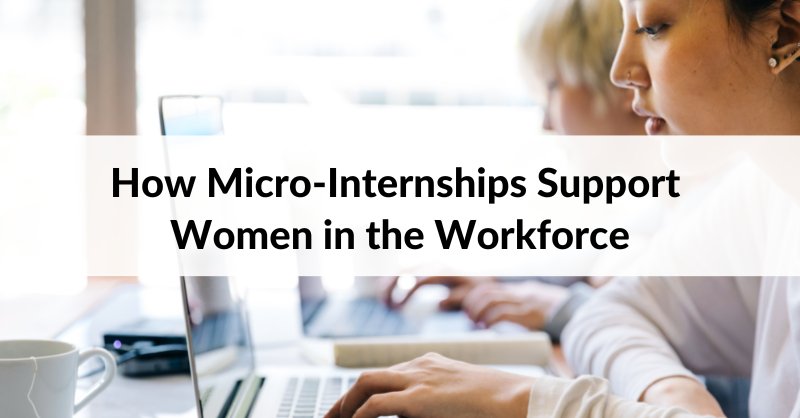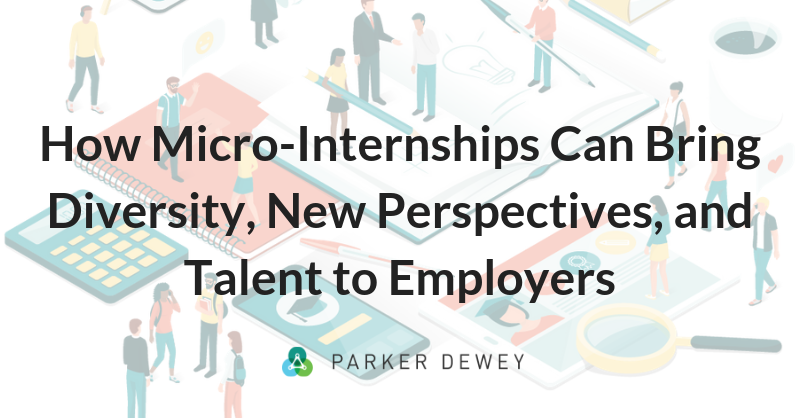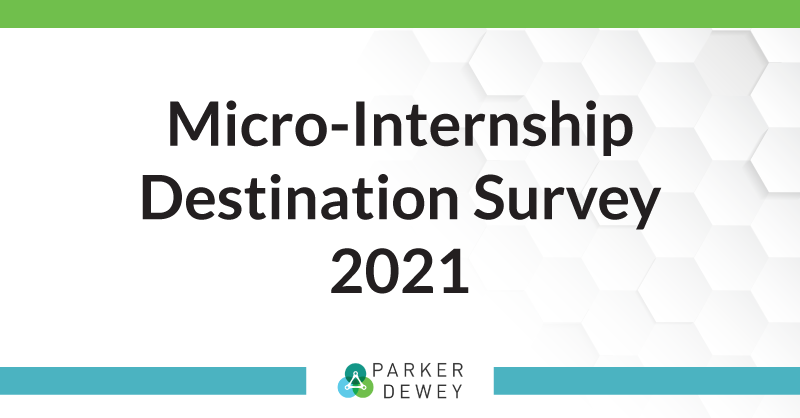
How Micro-Internships Support Women in the Workforce
In conversations about women, it’s not uncommon to hear emotional ties being invoked. Think of your sister/daughter/aunt/mother, someone might say. What kind of world or opportunities do you want for them? This argument could be employed when discussing points of access for women in the workforce, but it wouldn’t be the strongest one. If not for moral reasons, you should be making sure women are being proactively recruited at your workplace for this one: women are good for business.
How women benefit the workplaceAt a time when companies are struggling to attract and retain talent, one factor that plays into employee satisfaction might come as a surprise: the number of women employed by your company. Interestingly, research has shown that more women employees makes an organization more likely to be a better place to work for everyone, regardless of gender, leading to better retention and recruitment numbers.
To be clear, the benefits of women on your corporate team don’t stop at morale boosting. Women’s positive contributions lift moods as well as the bottom line. Research has shown that women’s presence from entry level opportunities to the boardroom positively impacts revenue. For example, gender-diverse teams and/or business units have higher sales, profits, and revenue compared to those led primarily by men. At the top of the ladder, Fortune 500 companies with the most female representation also financially outperform those where women are lacking.
Women can only get to those positions, however, if they are given equitable opportunities to enter and stay in the workforce. This is recognized and highlighted by the disproportionately few women who have made it to the top.
“We need women all the way up and down the pipeline, so senior matters and junior matters.”
- Sheryl Sandberg, Chief Operating Officer of Meta Platforms
Why employers aren’t fully engaging women
If studies make it clear that women’s presence benefits professional teams (and they do), why does men’s participation in the labor force outpace women’s by more than 10% in the United States? The short answer is that women face more professional barriers than men do, both when it comes to points of access and again when it comes to being able to remain in the workforce.
These inequities begin early, with women being 34% less likely to receive pay for their internships than men. This is particularly concerning when one takes into account that NACE research consistently shows that students who had paid internships are more likely to secure a job prior to graduation than those who had unpaid internships, or no internship at all.
Even if women are able to secure an entry point into the workforce, they often struggle to maintain and/or advance in their position. Some of this struggle to progress can be attributed to discrimination. In the tech industry for example, 50% of women have reported experiencing gender discrimination at work compared to 19% of men. The finance sector also sees significant drop-off in its female labor force as careers progress, with women beginning careers in this sector in roughly equal numbers to their male counterparts, but holding only 4.9% of senior roles in venture capital firms, despite evidence showing that women are actually better investors.
In addition to the previously mentioned discrimination, some of the struggle to stay in the workforce can be attributed to the overlap of a woman’s career-defining and childbearing years, coupled with the fact that 86% of women will become mothers by age 44. This overlap and the lack of affordable childcare in the United States inevitably leads to career breaks for many parents, but the pandemic also made it clear that caregiving responsibilities fall disproportionately to women. As of February 2022, men had largely regained their roles in the workplace, whereas there continued to be a million fewer women in the workforce than there had been in February 2020. Studies also showed that those who experienced the largest challenges during the pandemic were working mothers, women in senior management positions, and black women.
These career breaks, while necessary for many women to provide care for their families, can negatively impact not only their career progression, but also their ability to return to work at all, with one in five employers indicating that they would decline an applicant for an extended gap in their career history. In reality, these women should be considered a valuable talent pool, as more than half (54%) of women report that they are actually better at their job than they were before a career break, having acquired new and valuable skills during their time away.
The barriers women face to completing their education, workforce entry, and career progression will only continue to worsen with the recent overturn of Roe v Wade. While this impacts all women, according to the Lumina Foundation, 31% of college students come from families at or below the federal poverty level, thereby amplifying the impact on those who lack financial resources.
How Micro-Internships can Help
Employers can and should reframe their mindsets and hiring practices to create equitable, accessible entry and re-entry points for women, including the desirable, but often untapped applicant pool of women who have had to take a break early in their career. Parker Dewey Micro-Internships, which are short-term, paid, professional projects, are one method of doing so. This alternative to traditional hiring helps recruiters attract women in various ways:
-
Pay: Because all Parker Dewey Micro-Internships are paid, and the project pay is clearly posted for all who apply, women who are selected for Micro-Internships are ensured the same compensation and resulting opportunity as their male counterparts. That pay can also make a meaningful difference to a woman’s ability to afford and secure childcare for her first few weeks in a new role before that first paycheck comes through.
-
Efficiency: Applying for Micro-Internships is easy for candidates, just as posting a Micro-Internship is easy for companies. This allows women who, as we saw during the pandemic, are juggling a disproportionate amount of caregiving responsibilities, to be able to afford the time to apply for Micro-Internships.
-
Flexible/Remote: For the reasons described above, many women don’t have the means to hire someone to manage their caregiving responsibilities while they navigate an arduous in-person interview process. The remote, deadline-driven nature of Micro-Internships allows women to apply their skills to a project in their space and around their schedule, making it ideal for both women who are launching their careers from the start and those who are still early in their career and re-launching after a break. These short-term projects also allow women a flexible way to fill resume holes if an unexpected break from fulltime education or employment becomes necessary.
- A More Informed and Equitable Recruiting Process: Rather than making hiring decisions based solely on a person’s resume or how well they interview, Micro-Internships allow employers to make hiring decisions based on first-hand knowledge of whether a candidate has the skills to do the job. This allows women who have taken career breaks or those who may struggle to physically make it to an interview to demonstrate their potential through tangible project contributions.
-
A Proven Track Record: 80% of students selected for Parker Dewey projects come from underrepresented populations in the workforce. Using Micro-Internships as a recruiting tool can help you reap the rewards of a diverse team, including gender diversity.
In short, Micro-Internships give Career Launchers, including women like Yayra, Patricia, and Emma, an opportunity to show what they're capable of by making it easy for them to engage in an accessible hiring process.
Have an opening for early career talent? Use Micro-Internships to audition students and recent graduates in an equitable, accessible way.




.png)